
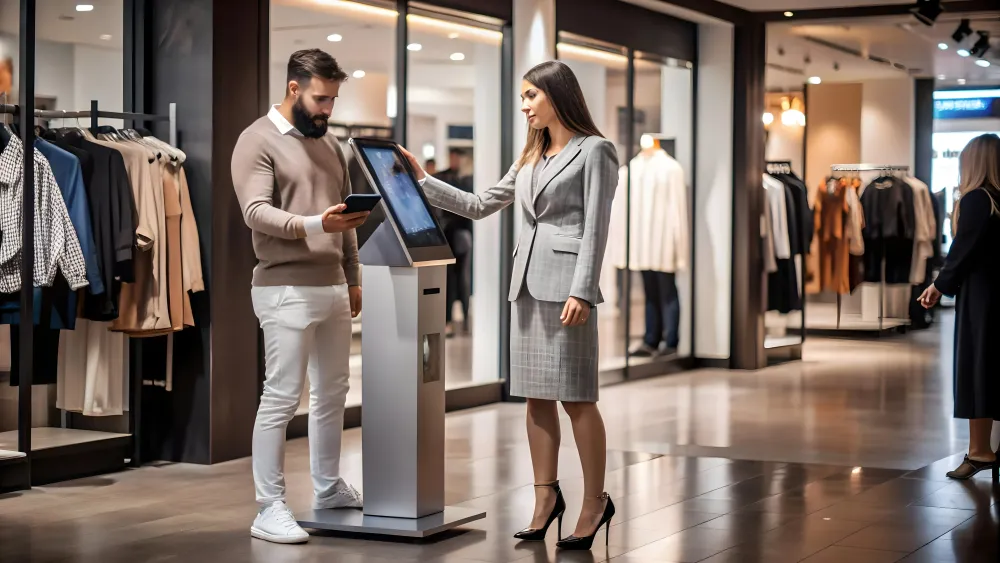
AI in Retail: From Personalization to Better Sales






The retail sector is undergoing a rapid AI-driven transformation. The global AI in retail industry was valued at around USD 11.61 billion in 2024 and is expected to reach USD 40.74 billion by 2030. This growth highlights the increasing importance of AI as retailers strive to meet customer demands for seamless and personalized shopping experiences across online, in-store, and mobile channels.
This is where Multimodal AI plays a significant role. Unlike traditional AI, which focuses on a single type of data, multimodal AI can understand text, images, voice, video, and even customer behavior simultaneously. It enables retailers to gain a deeper understanding of their shoppers and create personalized experiences in real-time.
In this blog, we’ll explore how multimodal AI powers modern retail, including its challenges, benefits, top use cases, and how to utilize it effectively.
Multimodal AI operates in a manner similar to how the human brain utilizes various senses to comprehend the world. Just as humans combine sight, sound, and touch to form a complete picture, multimodal AI brings together text, images, audio, video, and even customer behavior to create a richer understanding of shoppers. This makes it significantly more advanced than traditional AI, which typically operates with only one type of data.
Generative AI models that employ this multimodal approach can process multiple inputs simultaneously and produce accurate, context-aware outputs. In retail, this means the system can analyze a customer’s browsing history, the images they pause on, their voice searches, and even reviews they have written, all at once. The result is fewer errors, faster responses, and more personalized experiences.
As IoT devices and innovative technologies continue to evolve, retailers are collecting vast amounts of data from multiple sources. Multimodal AI helps make sense of all this information, turning it into meaningful insights. It also makes shopping more interactive and accessible, allowing customers to engage through voice, gestures, or even augmented reality. As models become faster, cheaper, and more powerful, multimodal AI is poised to transform retail in exciting new ways.
AI in retail depends on good data to deliver value. Retailers want deeper customer insights, optimized resources, and stronger sales, but practical challenges often slow down these goals. Here are some of the most common ones.
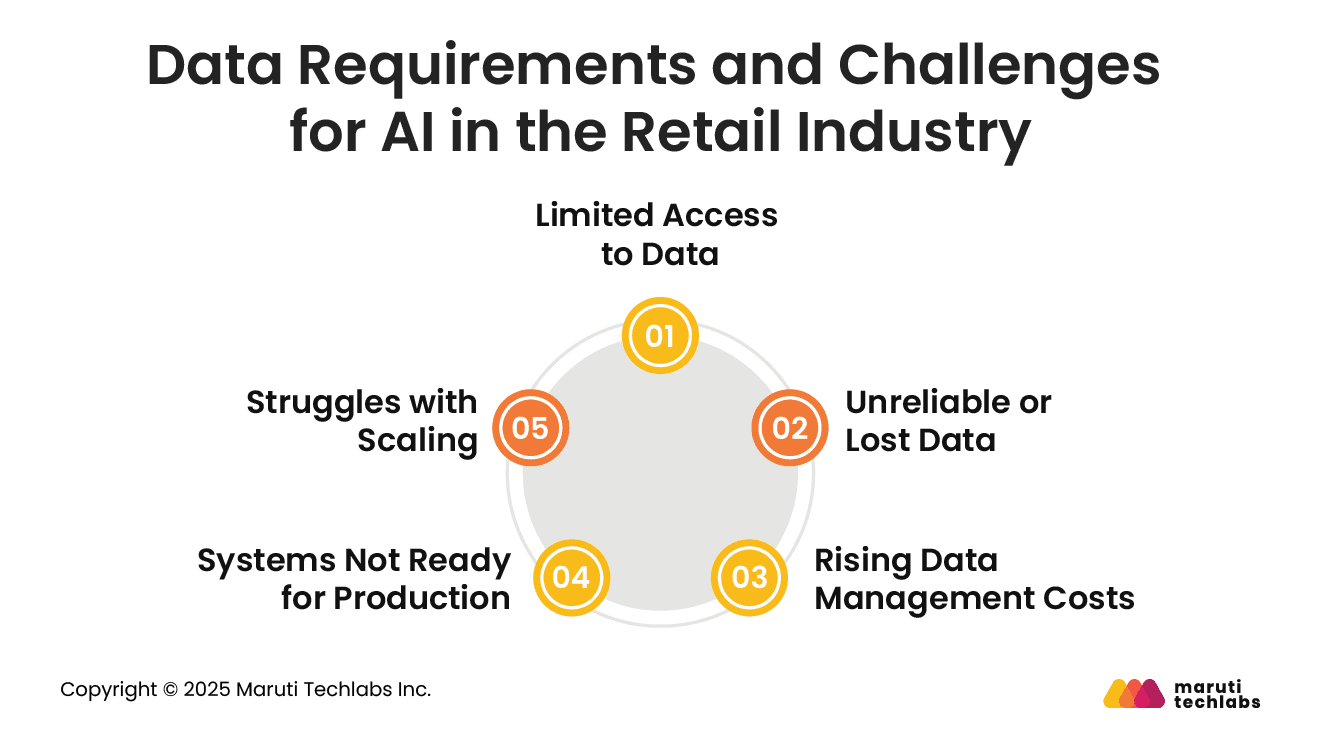
Retailers often face siloed data spread across multiple platforms and teams. This means that valuable information is often hidden, making it difficult for teams to obtain a comprehensive picture. Without easy access to the right data, building accurate AI models or making smart, shared decisions becomes much harder.
Outdated systems often leave retailers with inconsistent, incomplete, or obsolete data. Missing customer records and inaccurate purchase histories can lead to significant errors in AI-driven analysis. Since AI relies on clean, reliable inputs, poor data directly weakens insights and reduces trust in AI’s value for retail decision-making.
With the shift to cloud-based storage and processing, managing data has become more expensive. Costs often rise faster than the value being created, especially if resources are not used effectively. This makes it difficult for retailers to measure a clear return on investment from AI projects.
Even when AI models are built, moving them into real-world use is a major hurdle. Creating systems that can handle large volumes of complex retail data while ensuring performance and security can take months, delaying business impact.
Retail generates massive amounts of data every day. Scaling AI solutions to meet the growing needs of businesses, while maintaining speed and accuracy, remains one of the toughest challenges.
By addressing these issues, retailers can unlock the full potential of AI in retail and make multimodal systems truly effective for long-term growth.
Multimodal AI is transforming the AI landscape in the retail industry by leveraging data from multiple sources, including text, images, voice, and video, to deliver enhanced insights and experiences. Here are some key benefits:
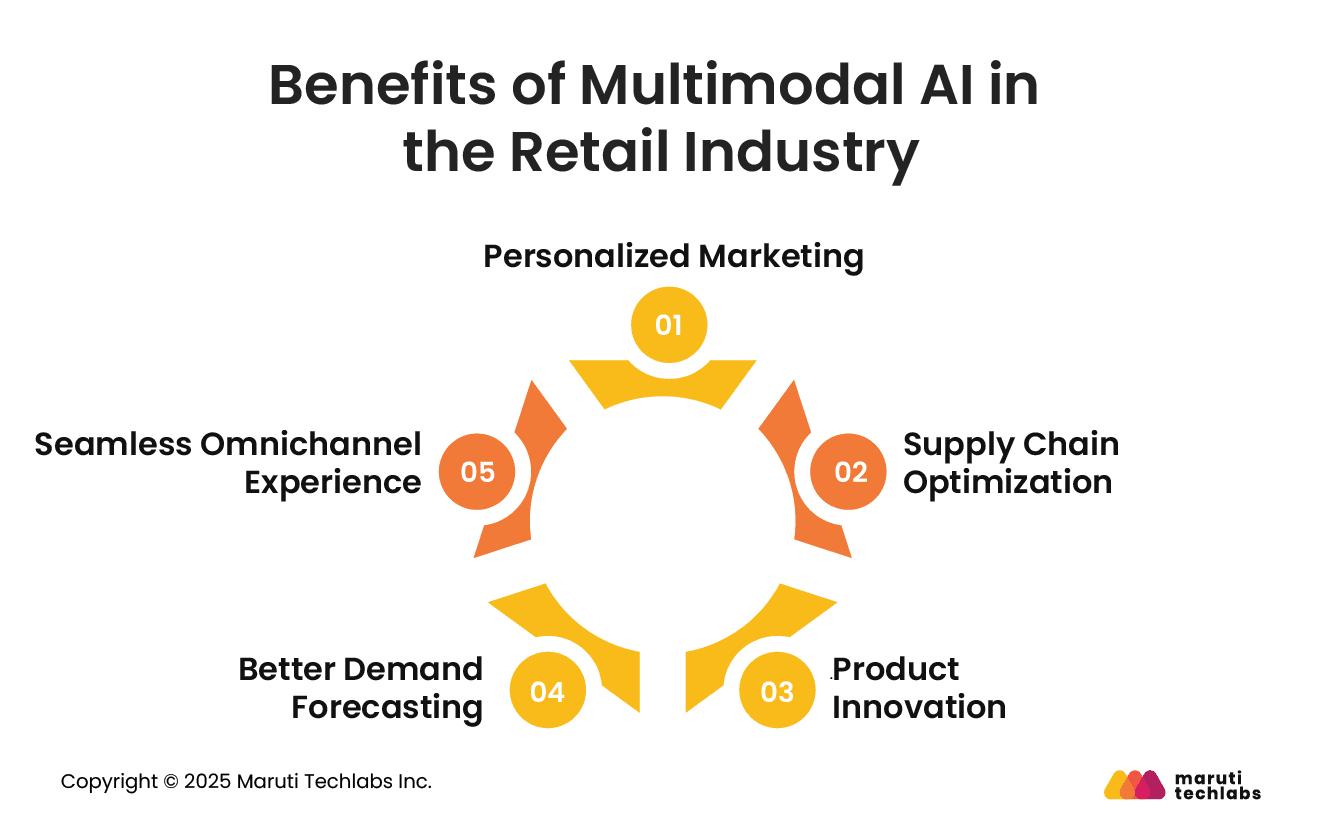
Multimodal AI studies customer behavior, shopping history, and sentiment to create personalized product recommendations and targeted campaigns. This improves customer satisfaction and builds loyalty.
By analyzing demand, stock levels, and product shelf life, AI in retail enables retailers to plan more effectively, minimize waste, and reduce the likelihood of stockouts.
Retailers and CPG companies can use multimodal AI to track trends and customer preferences across platforms. This enables them to design and launch products that truly meet customer needs.
Multimodal AI uses predictive analytics to combine past sales data with external factors. This results in more accurate forecasts, smarter inventory management, and fewer issues with overstocking or understocking.
AI in retail connects online and offline channels to deliver a consistent service experience. Customers get the same level of personalization and inventory accuracy whether they shop in-store, online, or on mobile.
By combining all these benefits, multimodal AI enables retailers to enhance efficiency, boost sales, and deliver improved customer experiences.
Multimodal AI is already having a significant impact on the retail industry. By combining text, images, video, and customer data, retailers can enhance efficiency, minimize errors, and deliver more personalized shopping experiences. Here are three major AI use cases in the retail industry.
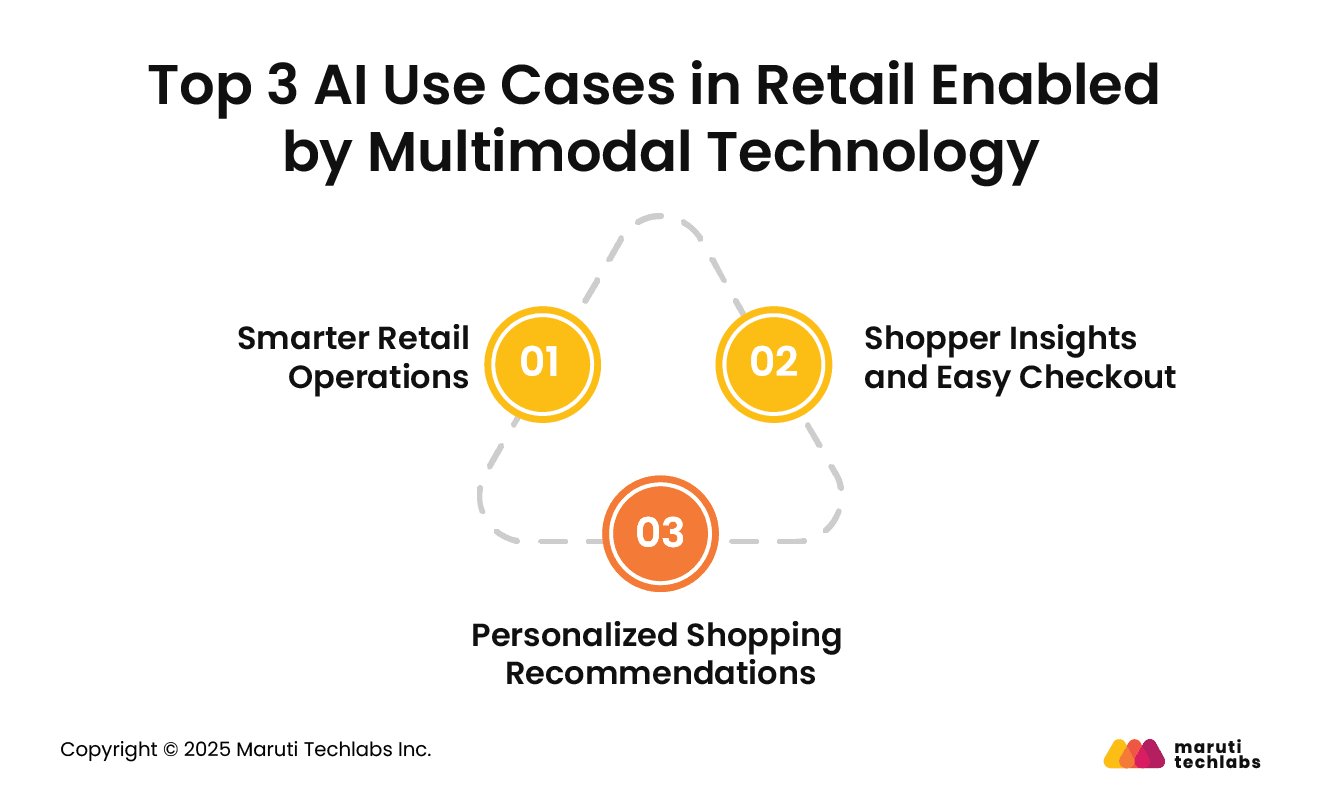
Retail operations rely heavily on accuracy. Multimodal AI helps track empty shelves, misplaced products, price mismatches, and even potential hazards inside stores. Instead of relying solely on manual checks, camera-based AI solutions scan shelves in real-time and compare them with product catalogs. These systems continually improve over time as they learn from in-store data, enabling retailers to save time, reduce errors, and maintain a seamless shopping experience.
One of the primary goals in the AI-driven retail industry is to make shopping as seamless as possible. With AI models powered by sensors and cameras, retailers can analyze how shoppers navigate through the store, which products they interact with, and how much time they spend in different sections.
The same technology also enables frictionless checkout, allowing customers to pick up items and leave without waiting in long lines. These insights enable retailers to design more effective store layouts and enhance category management.
Personalized recommendations are one of the most common AI use cases in retail. Multimodal AI looks at what customers like, how they shop, and even product details such as color or style. Using this information, it suggests items that match their taste, whether they are browsing online or in a store. This makes shopping easier for customers and helps retailers in the retail industry increase sales.
Adopting multimodal AI in retail may seem complex at first, but with a clear strategy, it becomes far more manageable. By taking the right steps, retailers can enhance customer experiences, streamline operations, and boost sales.
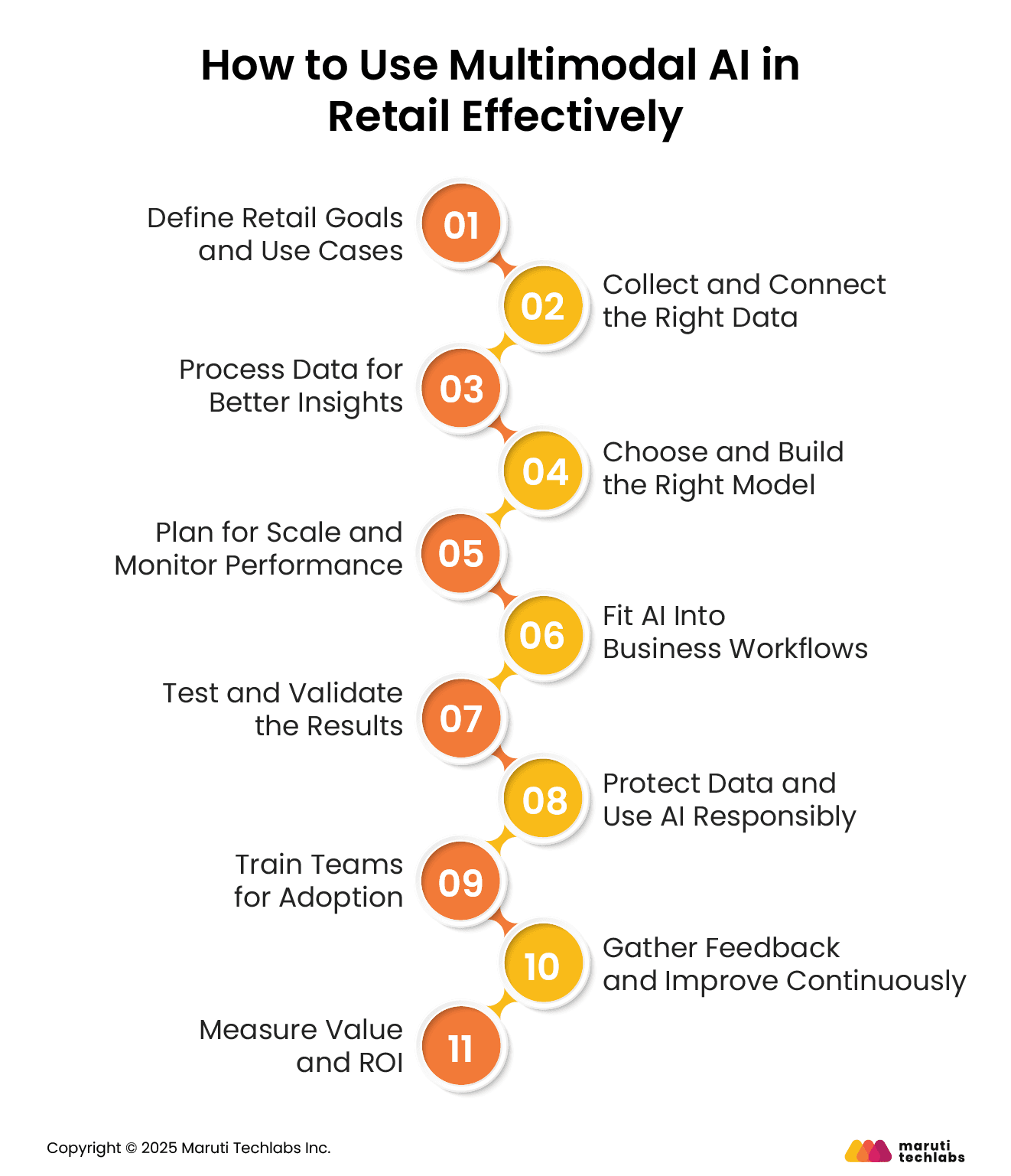
The first step is to be clear about what you want to achieve. Retailers should identify specific business goals, such as improving customer service, reducing stockouts, or personalizing the shopping experience. Choosing particular AI use cases makes it easier to measure success.
AI in retail works best when the data is clean and well-organized. Stores need to consolidate details from sales, customer interactions, and stock systems into a single location. This provides a clear and comprehensive view of the business that can be utilized across various apps and tools.
Once data is collected, it must be cleaned and processed. This step ensures that the inputs used for AI models are accurate and useful. Reliable data processing improves the overall quality of AI insights.
Retailers don’t always need to develop AI models from scratch. Often, smaller models trained on retail-specific data deliver more accurate results than large, general-purpose ones. The best approach depends on the business use case and budget.
Retail generates massive volumes of data every day. Multimodal AI systems should be able to scale as data grows. Regular monitoring of performance helps manage costs and ensures that customers receive quick and accurate results.
Technology alone isn’t enough. AI tools must be integrated into everyday retail processes, such as supply chain management, marketing campaigns, and store operations, to ensure that insights are seamlessly translated into real actions.
AI in retail should be thoroughly tested to reduce errors and ensure dependable results. With human oversight and validation, insights gain credibility, allowing retailers to confidently apply them in daily operations.
Since retailers manage sensitive customer data, ensuring privacy and upholding ethical standards is essential. Strong data governance ensures that information is used securely and responsibly, protecting both businesses and customers.
For AI to really work in retail, staff need the right training. When employees understand how technology supports their daily tasks, it becomes easier for everyone to adopt and utilize it effectively.
Retail is constantly changing, and so should AI. Collecting feedback from employees and customers helps refine AI systems and make them more accurate over time.
Ultimately, retailers must verify whether the investment is yielding a return. Tracking return on investment (ROI) helps demonstrate the tangible value of multimodal AI in retail, whether it’s increased sales, reduced errors, or improved customer satisfaction.
Multimodal AI is changing retail in significant ways. It is not just another trend, but a shift in how shopping experiences are built. From predicting what customers may want to making every interaction smoother, this technology is helping retailers create more personal and meaningful connections.
The key to maximizing the benefits of multimodal AI is to utilize it effectively. Bring together the right data, test carefully, train your team, and track the real impact on your business. When done right, it goes beyond selling products and builds lasting customer relationships.
At Maruti Techlabs, we help retailers assess, plan, and implement AI solutions that truly make a difference. With a focus on Custom AI Development, we design and deliver solutions tailored to your business needs. Contact us to initiate a conversation.
To get started, try our AI Readiness Assessment Tool and discover how prepared your retail business is for successful AI adoption.
AI enables retailers to understand their customers better, predict demand, and enhance operational efficiency. It can personalize shopping, recommend products, and even prevent stock issues. For retailers, this means happier customers, smarter decisions, and higher sales, all while reducing time spent on repetitive tasks.
AI shows up in product recommendations, virtual shopping assistants, dynamic pricing, demand forecasting, and inventory management. It also powers cashier-less stores, personalized marketing, and chatbots for support. These uses help retailers make shopping smoother for customers while boosting sales and reducing everyday challenges.
Start small by using AI for product recommendations, chatbots, or demand forecasting. As your team becomes more comfortable, consider expanding to customer insights, personalized marketing, or inventory optimization. With the right tools and training, AI becomes part of everyday processes, making retail smarter and more customer-friendly.
AI makes online shopping faster, easier, and more personal. It powers product suggestions, smarter search, dynamic pricing, and customer support chatbots. By analyzing browsing and purchasing patterns, AI helps retailers anticipate customer needs and deliver relevant products often before customers even begin searching.


